At its GPU Technology Conference Nvidia Corp. revealed some details about its next-generation code-named “Pascal” architecture of graphics processing units. As expected, the new GPUs will feature numerous innovations that will provide significant benefits in performance in various types of applications.
Nvidia noted three key technologies that the “Pascal” GPUs will have: mixed precision computing, support for stacked multi-layer 3D memory and NVLink GPU bus. As reported previously, the “Pascal” GPUs will be made using 16nm FinFET process technology, therefore, expect increased count of stream processors, and higher clock-rates in addition to architectural enhancements. According to Nvidia, in peak cases, when all improvements come into play, “Pascal” GPUs can be 10 times faster than “Maxwell” GPUs. In typical cases expect next-gen GPUs to be around two times faster than contemporary graphics chips.

Mixed-precision computing enables “Pascal” architecture-based GPUs to compute at 16-bit floating point accuracy at twice the rate of 32-bit floating point accuracy, which is useful for a number of GPGPU tasks. In certain cases GPUs could do graphics work with 16-bit FP precision without degradation of quality, but not in all of them.
Stacked multi-layer 3D memory will increase memory bandwidth available to new GPUs. Nvidia does not reveal what kind of memory it plans to use, but depending on the Pascal’s availability timeframe, it could be first-generation HBM (with up to 640GB/s bandwidth) or second-generation HBM with unprecedented capacities and north from 1TB/s bandwidth. Extreme memory bandwidth brings benefits to virtually all types of applications, including video games. Graphics cards featuring “Pascal” GPUs and second-gen HBM will carry up to 32GB of memory, according to Nvidia.
NVLink is an energy-efficient, high-bandwidth bus that will be used for communications between Nvidia GPUs and IBM Power processors in supercomputers as well as for multi-GPU communications. Initial NVLink data-rates will be “at least” 80GB/s, but eventually NVLink’s bandwidth will be increased to 192GB/s or even higher.
Nvidia plans to release its first “Pascal” GPUs in 2016.
Discuss on our Facebook page, HERE.
KitGuru Says: While “Pascal” GPUs will not be 10 times faster than “Maxwell” graphics processors in all types of applications, expect the upcoming GPUs to offer significantly higher performance than predecessors due to increased amount of execution units, higher clock-rates, massively increased memory bandwidth and architectural enhancements. The majority of innovations will be enabled by thinner manufacturing process.
 KitGuru KitGuru.net – Tech News | Hardware News | Hardware Reviews | IOS | Mobile | Gaming | Graphics Cards
KitGuru KitGuru.net – Tech News | Hardware News | Hardware Reviews | IOS | Mobile | Gaming | Graphics Cards



Again nvidia’s marketing stunt ,,,,,,,,, wake up nvidia coz amd already has 1.2 terabyte/sec in hand 4X more than nvidia
And nvidia plz answer whats ur plan to tackle HSA,, nvlink is abruptly costly so hsa will rule no doubt no matter by amd product or from anyone else
I’m sorry to give you a wake up call, but between your evident lack of knowledge a horrible spelling no one knowledgeable will take you seriously.
I’m sorry to give you a wake up call, but between your evident lack of knowledge and a horrible spelling no one knowledgeable will take you seriously.
Are you sure they don’t mean 9.5 times faster xD (Sorry couldn’t resist). Nvidia has proven their marketing teams cannot count, so I take their announcements with a healthy dose of skepticism.
10x faster than Maxwell is Impossible and its a pure marketing stunt by nVidia as usual
AMD fanboy :/
AMD make awesome cards – then nvidia make a even more awesome card – then amd make a even awesome card and so on.
This is great for all gamers and all that use pc. Don’t be a fanboy. AMD make awesome stuff and so do Nvidia.
But please give a link for the source of the info you got. I never heard about 1.2terabyte/sec from AMD or Nvidia.
Oh yeah? Where’s your source or are you pulling that from your arse?
I’m pretty sure nvidia knows more that you about their next gpus
First we hv to look how hbm works.
Let us suppose Each stack hv 1024 bit wide bus so if amd uses 2 stack then it will be 2×1024 bit wide bus in short 2X bandwidth nd capacity.
As Previously said amd is using 4gb memory means 4 stack high so 4×1024 bit wide bus and 4×8gigabit(1gb) means 4gb capacity.
Now if amd is using 8gb memory that means 8×1024 bit bus,, coz only in that case amd can use 8 GB memory ,,reason is hbm is available only in 8gbit(1gb) size, u can check on SK hynix website.
And about titan is good card or not then its completely depend on performance per dollar per watt or fanboyism and considering 999$ price tag i give 8gb 390x pick and kick for Titan coz AAA gaming on 4k requires 8gb memory and 800+ GB/sec bandwidth (if we r not using tiled resources or other tricks)
Nvidia fanboys hv right to protest……………..
Mobile typing so my bad
Just like they knew how much memory was on their own 970’s? You know, the ones they manufacture and definitely should “know more that you about their next gpus”.
When you take everything said by a company at face value, especially when that company is trying to sell and/or market an upcoming product then you’re naive
Even your excuse about your grammar being ‘mobile typing’ wont save you now from awful grammar. Now here how it goes. Titan is NOT a gaming card. Its a mix between quadro and gtx cards. Titan is for those who wants always top notch and are willing to spend money on it. Gtx 970 having a 192bit interface can handle games at 4k and you are talking about that HBM is a must need to be able to play games on 4k. Makes no sense
Its not 9.5 times faster… ITS 10 TIMES FASTER!! means.
3.5+0.5, 3.5+0.5= 8 times.
1.75+0.25=10 times.
anyway its 8.75 times faster.
You do know that 390x is not out yet? and no one know what the specs will be. It looks to be awesome, thats for sure. but you are saying that AMD already has 1.2TB/sec on a card that is not out yet? Why no wait and see what the make before saying stuff like this will be better then that. No one knows anything about it before it hit the market. 🙂
And this news is not about Titan. No one in the right mind buys titan for gaming. (my opinion)
I like to see what AMD makes when the day come we can buy 390x 🙂 and next what Nvidia make 🙂
4K forces Nvidia and AMD to make better and faster cards and that awesome and great news for os all.
Not all is perfect at gramma, some of os i dyslexia and we/i are trying to type right so you can read it and understand it. So please don’t be a grammar nazi :/
✈✈✈✈✈✈✈✈Make over 13k/M0NTH@af4:
Going Here you
Can Find Out,,
,
►►► ::>>https://WorkOnlineStore.com/get/position…
Why not 100x then 10x ??
Shouldn’t you take the announcement of any marketing team, not matter which company they belong to, with a healthy dose of skepticism? Seems kind of an obvious point, marketing tries to present the company in the best possible way, almost always not adhering to actual real-life use of a product. The only difference is that Nvidia has been recently caught in somewhat of a scandal of course.
Same with AMD, intel any any other company. How inferior Freesync is and the 970 memory shennanigans (even though it has 0 effect on me getting 60fps 4k with SLI, withotu stutter) and the AMD 8 cores not being true 8 Cores. All in all I agree with what you said but only if you mean EVERY COMPANY, not just Nvidia
Yo, stupid person, the memory capacity of the 970 is as much as it was said it is – 4gb. It’s the speed of one 512 mb block that was wrongly advertised. Mind gathering some info before commenting? Idiot.
They said that in typical cases it will be about two times faster. I think it will be 10 times faster for some applications that use a lot of bandwidth.
If u want to play project igi on 4k using gtx 970 then cheers to u.
I am talking about AAA games developed on next gen engines like cry engine 4,fox engine etc
Last gen games like battlefield 3 was originally developed for ps3 then ported to PC so if ur aim is to play last gen game on 4k then nothing to say… well my frnd already have evga gtx 970 and it cries on 4k so can u plz tell me which game u r playing on 4k all max setting and getting 60 fps??????????
Then out of nowere, everyone is tricked by nvidia and realise they should have bought a amd…
Nope. 🙂
Buy the card that have the feature you want. You want g-sync? buy Nvidia or wait for freesync to come out. You want mantle? buy AMD or wait to DX12 to come out. Or get that card that was use to make a game. Like Farcry 4 use Nvidia and use alot stuff from Nvidia. Or Like Battlefield 4 go get AMD to get better performens. It all come down to what you do and play. 🙂
Nothing to do with mobile typing. For the future, if you wand anyone on any decent level to treat you seriously, learn that:
1. Nvidia is a name and as such always start with a capital letter.
2. Coz, plz and ur are not real words and have nothing to do with mobile typing.
3. Proper punctuation goes a long way.
Well look who was right 😉
AMD did not get 1.2terabyte/sec, thy only got 512GB/sec.
So next time please wait before saying stuff like that where you don’t know whats going to happen 🙂
I’m not a fanboy, but AMD’s technology still behind from Nvidia..